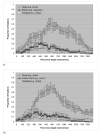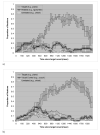Impaired access to manipulation features in Apraxia: evidence from eyetracking and semantic judgment tasks
- PMID: 20064657
- PMCID: PMC2853734
- DOI: 10.1016/j.bandl.2009.12.003
Impaired access to manipulation features in Apraxia: evidence from eyetracking and semantic judgment tasks
Abstract
Apraxic patients are known for deficits in producing and comprehending skilled movements. Two experiments tested their implicit and explicit knowledge about manipulable objects in order to examine whether such deficits accompany impairment in the conceptual representation of manipulation features. An eyetracking method was used to test implicit knowledge (Experiment 1): participants viewed a visual display on a computer screen and touched the corresponding object in response to an auditory input. Manipulation relationship among objects was not task-relevant, and thus the assessment of manipulation knowledge was implicit. Like the non-apraxic control patients, apraxic patients fixated on an object picture (e.g., "typewriter") that was manipulation-related to a target word (e.g., 'piano') significantly more often than an unrelated object picture (e.g., "bucket") as well as a visual control (e.g., "couch"). However, this effect emerged later than in the non-apraxic control group, suggesting impaired access to manipulation features in the apraxic group. In the semantic judgment task (Experiment 2), participants were asked to make an explicit judgment about the relationship of picture triplets of manipulable objects by choosing the pair with similar manipulation features. Apraxic patients performed significantly worse on this task than the non-apraxic control group. Both implicit and explicit measures of manipulation knowledge show that apraxia is not merely a perceptuomotor deficit of skilled movements, but results in a concomitant impairment in representing manipulation features and accessing them for cognitive processing.
Copyright 2009 Elsevier Inc. All rights reserved.
Figures





Similar articles
-
Abnormal dynamics of activation of object use information in apraxia: evidence from eyetracking.Neuropsychologia. 2014 Jul;59:13-26. doi: 10.1016/j.neuropsychologia.2014.04.004. Epub 2014 Apr 16. Neuropsychologia. 2014. PMID: 24746946 Free PMC article.
-
Playing on the typewriter, typing on the piano: manipulation knowledge of objects.Cognition. 2006 Jan;98(3):223-43. doi: 10.1016/j.cognition.2004.11.010. Cognition. 2006. PMID: 16399263 Clinical Trial.
-
Distinctions between manipulation and function knowledge of objects: evidence from functional magnetic resonance imaging.Brain Res Cogn Brain Res. 2005 May;23(2-3):361-73. doi: 10.1016/j.cogbrainres.2004.11.001. Epub 2005 Jan 7. Brain Res Cogn Brain Res. 2005. PMID: 15820643
-
Knowledge of object manipulation and object function: dissociations in apraxic and nonapraxic subjects.Brain Lang. 2002 Aug;82(2):179-99. doi: 10.1016/s0093-934x(02)00014-7. Brain Lang. 2002. PMID: 12096875
-
[Apraxia--neuroscience and clinical aspects. A literature synthesis].Nervenarzt. 2005 Oct;76(10):1209-10, 1213-4, 1216-8, 1220-1. doi: 10.1007/s00115-005-1936-3. Nervenarzt. 2005. PMID: 15937712 Review. German.
Cited by
-
Reply: apraxia: a gestural or a cognitive disorder?Brain. 2015 Mar;138(Pt 3):e334. doi: 10.1093/brain/awu240. Epub 2014 Aug 29. Brain. 2015. PMID: 25173604 Free PMC article. No abstract available.
-
Incidental and context-responsive activation of structure- and function-based action features during object identification.J Exp Psychol Hum Percept Perform. 2013 Feb;39(1):257-70. doi: 10.1037/a0027533. Epub 2012 Mar 5. J Exp Psychol Hum Percept Perform. 2013. PMID: 22390294 Free PMC article.
-
A combination of thematic and similarity-based semantic processes confers resistance to deficit following left hemisphere stroke.Front Hum Neurosci. 2012 May 4;6:106. doi: 10.3389/fnhum.2012.00106. eCollection 2012. Front Hum Neurosci. 2012. PMID: 22586383 Free PMC article.
-
Abnormal dynamics of activation of object use information in apraxia: evidence from eyetracking.Neuropsychologia. 2014 Jul;59:13-26. doi: 10.1016/j.neuropsychologia.2014.04.004. Epub 2014 Apr 16. Neuropsychologia. 2014. PMID: 24746946 Free PMC article.
-
Learning Is Better with the Hands Free: The Role of Posture in the Memory of Manipulable Objects.PLoS One. 2016 Jul 14;11(7):e0159108. doi: 10.1371/journal.pone.0159108. eCollection 2016. PLoS One. 2016. PMID: 27414407 Free PMC article.
References
-
- Allport DA, Epstein R. Distributed memory, modular subsystems and dysphasia. In: Newman SK, editor. Current perspectives in dysphasia. Churchill Livingstone; Edinburgh: 1985.
-
- Altmann G, Kamide Y. Now you see it, now you don’t: mediating the mapping between language and the visual world. In: Henderson J, Ferreira F, editors. The interface of language, vision, and action. Psychology Press; 2004.
-
- Barsalou LW. Perceptual symbol systems. Behavioral and Brain Sciences. 1999;22:577–660. - PubMed
-
- Barsalou LW, Simmons WK, Barbey AK, Wilson CD. Grounding conceptual knowledge in modality-specific systems. Trends in Cognitive Sciences. 2003;7(2):84–91. - PubMed
-
- Blumstein S, Milberg W, Shrier R. Semantic processing in aphasia: Evidence from an auditory lexical decision task. Brain and Language. 1982;17:301–315. - PubMed
Publication types
MeSH terms
Grants and funding
- MH070850/MH/NIMH NIH HHS/United States
- MH62566/MH/NIMH NIH HHS/United States
- R24 HD050836/HD/NICHD NIH HHS/United States
- R29 NS036387/NS/NINDS NIH HHS/United States
- R01 NS036387/NS/NINDS NIH HHS/United States
- R01 MH062566/MH/NIMH NIH HHS/United States
- R01 AG014345/AG/NIA NIH HHS/United States
- HD050836/HD/NICHD NIH HHS/United States
- NIDCD00314/PHS HHS/United States
- R01 DC000314/DC/NIDCD NIH HHS/United States
- NS36387/NS/NINDS NIH HHS/United States
- NIDCD0081/PHS HHS/United States
- P50 DC000081/DC/NIDCD NIH HHS/United States
- R01 MH070850/MH/NIMH NIH HHS/United States
LinkOut - more resources
Full Text Sources

